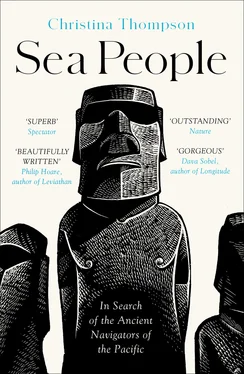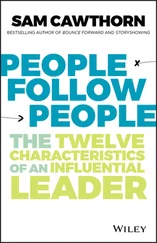Cook at this moment probably knew more about the Pacific than any living European. He had made three voyages in ten years, each of several years’ duration, and had visited every major island group in Polynesia. He had witnessed dozens, perhaps hundreds, of gatherings, many occasioned by the arrival of his own ships, but nowhere, he wrote, had he ever seen so many people assembled in one place at one time. Cook estimated that no fewer than a thousand canoes came out to meet them, while “all the Shore of the bay was covered with people and hundreds were swimming about the Ships like shoals of fish.” But it was not just the numbers that impressed him; it was the mood. Early encounters between Europeans and Pacific Islanders were frequently tense; often there were skirmishes, sometimes people were killed. On this occasion, however, the atmosphere seemed strangely festive. As Cook and his officers noted with some surprise, the islanders were not even armed.
As soon as the Englishmen landed, they were escorted up the beach to the heiau , preceded by heralds who called out, “Orono, Orono.” Spectators, who had gathered in the hundreds along the shore, flung themselves to the ground as the strangers approached, prostrating themselves before the procession. Cook was led up onto the platform, draped in a red cloth, and presented with offerings of cooked pig. A pair of priests chanted, alternately addressing Cook and a collection of wooden images, while the crowd intoned “Orono” at intervals. Even within Cook’s extensive experience, this reception was unique, and it quickly became clear to everyone present—as it has been to every historian and anthropologist since then—that something quite out of the ordinary was going on.
There have been varying interpretations of these events over the years, but the most widely accepted view is that, by sheer chance, Cook had arrived in the Hawaiian Islands during a seasonal ritual cycle known as the Makahiki. The central event of this festival, which runs from October to February, is the return of the god Lono, who arrives from Kahiki (the Hawaiian name for Tahiti but also a word meaning “a faraway place”) and is ritualistically borne around the island in a clockwise fashion, visiting each district in turn and collecting tributes. Lono, a god of peace and fertility, is represented in this procession by a long pole with a crosspiece draped with white cloth.
By the queerest twist of fate, Cook himself had been slowly sailing around the island in a clockwise direction, in a ship with tall masts and white sails, during precisely these months and had come ashore at a place specifically consecrated to the god Lono. Thus it was that he was received as a temporal embodiment of the god. This is not to say that Cook was “mistaken” for the god Lono—a crude, if common, misinterpretation—but rather that, coming as he did, when he did, he was understood to be cloaked in the mantle of the deity’s power.
For two weeks, Cook’s ships remained in Kealakekua Bay, and for two weeks the extraordinary obeisances continued. At the end of January, Whatman died and was buried in the heiau with both Christian and Hawaiian honors, Cook reading the burial service and the Hawaiian priests contributing a pig to the grave. Three days later, the ships weighed anchor and sailed away. And that should have been the end of the story. But a few days out, the foremast of Cook’s ship split in a gale and he turned back to Kealakekua to make repairs. This time almost no one came out to meet them.
Cook himself had the feeling that they had outstayed their welcome, but what he could not have known was that there was a deeper, more metaphysical problem. As the embodiment of Lono, he was supposed to leave at the end of the Makahiki season, with a promise to return—but not until the following year. When, instead, he returned almost immediately, his reappearance proved impossible to explain. The then-reigning chief of Hawai‘i, Kalani‘ōpu‘u, dismissed the Englishmen’s account of technical difficulties, insisting, rather, that on his earlier visit Cook had “amused them with Lies.”
The air of festivity that had characterized the Makahiki was now at an end, and the mood in the bay was marked by irritability and mistrust. On shore, the carpenters worked away at the mast, but there were thefts and disagreements, punishments and disputes. Then, on the third day, in one of those fracases that so often erupted in these situations—a shout and a shove and a discharged weapon—Cook was killed. It was almost absurdly accidental, and it might so easily have happened at any time, in more or less this way, on any of a number of islands. But this was how and where it did happen, here in Kealakekua Bay.
THE SPOT WHERE Cook was killed lies about a mile from the heiau , across the bay at a place called Ka‘awaloa. A twenty-five-foot-high white obelisk, erected there in his memory in 1874, appears to the naked eye as a small white object on a low green promontory, or, with a bit of magnification, like the top of a tiny white church buried up to its steeple in the ground. There is no road down to Ka‘awaloa, and the only ways to reach the monument are by hiking down from the highway or sailing or motoring into the bay or paddling across in a kayak from the nearby Napo‘opo‘o pier.
Seven and the boys were curious about the kayaks, so we drove over to Napo‘opo‘o to have a look. Unlike the heiau , which retains much of the solemnity of a church, the Napo‘opo‘o pier is a hive of activity. The parking lot was full of vans loading and unloading kayaks in every imaginable color. Tanned, athletic-looking tourists milled about in bathing suits and life jackets while big Hawaiian guys with tattooed calves sauntered back and forth with armloads of bright yellow paddles. It was clear that the Hawaiians were in charge of the rentals, so Seven went over to have a word with one of them.
“Hey,” he said, “how much for a kayak?”
“Thirty dollars,” the guy replied. And then, “Twenty for you, brother.”
At this point, we had been traveling in the Pacific for almost eight weeks. We had had our passports stamped in six different countries, touched down on fourteen different islands, learned how to say hello in eight different (albeit closely related) languages, and in every single place there had been an encounter like this. Hey, brother, how’s it going? Hey, brother, where you from? Hey, brother, you need something? In Tonga, a man with whom we had only the most distant connection loaned us his car. In Hawai‘i, the cousin of an acquaintance offered us her house. On islands all over the Pacific, people stopped to ask my husband who he was and where he was from.
The reason for this is that Seven is Polynesian. He is Māori, which is to say that he belongs to the branch of the Polynesian family that settled the islands of New Zealand around the beginning of the second millennium A.D. Hawaiians are also Polynesians: they belong to the branch of the family that settled the Hawaiian Islands a bit earlier, around the end of the first millennium. Both groups can trace their roots back to the islands of central Polynesia—to Tahiti and the Society Islands, the Marquesas, and the Cooks—which were settled, in turn, by voyagers from islands farther to the west. So rapid and complete was this expansion, and so vast the territory across which it spread, that, until the era of mass migration, Polynesians were both the most closely related and the most widely dispersed people in the world.
Seven’s encounter with the kayak dealer was a legacy of this prehistoric diaspora, and, like the stonework of the Hikiau Heiau, we had encountered it before, thousands of miles away in the Tuamotus, on Tahiti, and Tongatapu. But the amazing thing is that we could have gone on traveling for thousands more miles and visited hundreds more islands and the experience would have been the same. Because the fact is that Seven can get on a plane in the country of his birth, fly for nine hours, and get off in a completely different country where he will be treated by the locals as one of their own. Then, if he wants, he can get on another plane, fly for nine hours in an entirely different direction, get off, and still be treated like a local. And then, if he wants to go back to where he started, it’s still another nine hours by plane.
Читать дальше












